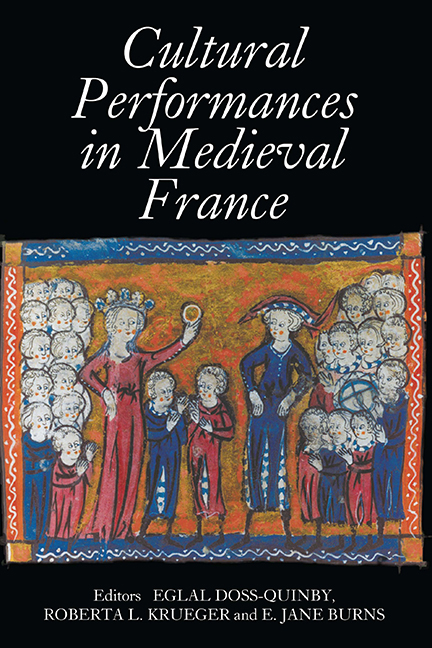Book contents
- Frontmatter
- Contents
- List of Illustrations
- Contributors
- Introduction
- Nancy Freeman Regalado, Curriculum Vitae
- PART I POETIC AND MUSICAL PERFORMANCES
- PART II PERFORMING SEXUAL AND SOCIAL IDENTITIES
- Intimate Performance: An Ivory Writing Tablet Cover at The Cloisters
- A Cultural Performance in Silk: Sebelinne's aumousniere in the Dit de l'Empereur Constant
- Acting Like a Man: Performing Gender in Tristan de Nanteuil
- Amorous Performances: The Aventure de l'espee vermeille in Perceforest
- Historicizing Performance: The Case of the Jeu de Robin et Marion
- The Protean Performer: Defining Minstrel Identity in Tristan Narratives
- PART III DEVOTIONAL PRACTICE AND TEXTUAL PERFORMANCE
- PART IV PERSUASIVE PERFORMANCES
- PART V RE–ENACTMENTS AND LEGACIES
- Tabula Gratulatoria
- Tabula Gratulatoria
Acting Like a Man: Performing Gender in Tristan de Nanteuil
from PART II - PERFORMING SEXUAL AND SOCIAL IDENTITIES
Published online by Cambridge University Press: 24 October 2017
- Frontmatter
- Contents
- List of Illustrations
- Contributors
- Introduction
- Nancy Freeman Regalado, Curriculum Vitae
- PART I POETIC AND MUSICAL PERFORMANCES
- PART II PERFORMING SEXUAL AND SOCIAL IDENTITIES
- Intimate Performance: An Ivory Writing Tablet Cover at The Cloisters
- A Cultural Performance in Silk: Sebelinne's aumousniere in the Dit de l'Empereur Constant
- Acting Like a Man: Performing Gender in Tristan de Nanteuil
- Amorous Performances: The Aventure de l'espee vermeille in Perceforest
- Historicizing Performance: The Case of the Jeu de Robin et Marion
- The Protean Performer: Defining Minstrel Identity in Tristan Narratives
- PART III DEVOTIONAL PRACTICE AND TEXTUAL PERFORMANCE
- PART IV PERSUASIVE PERFORMANCES
- PART V RE–ENACTMENTS AND LEGACIES
- Tabula Gratulatoria
- Tabula Gratulatoria
Summary
For scholars of the Middle Ages, the old French chanson de geste has traditionally served as the benchmark for one extreme of a continuum of representation, a genre expressing the distilled essence of the medieval masculine. This reading of the epic presumes a transparent equivalence of the masculine with the body and actions of the knight, constructing the “male” as a necessary element in an ideology of chivalric caste and power. Furthermore, this definition of the masculine is, in Simon Gaunt's words, “monologic,” meaning that “in the chansons de geste male characters are defined as individuals in relation to other men, whilst women are excluded from the genre's value system.” Sarah Kay would seem to agree, seeing the chanson de geste as the literary embodiment of Georges Duby's model of a feudal power that reduces “women to the status of transparent objects via which transactions between men, such as dynastic alliances and inheritance, are vehicled.” The feminine “other” is restricted to a transactional function, serving, in Kay's words, as a “prop to the ideal of masculine collectivity,” in a system in which the indissolubility of the constituent terms of the identity of the male knight is taken for granted.
However, the chanson de geste is a long-lived genre; later poets are not unaware of the tensions generated by the silencing of plurality inherent to the epic articulation of the male-as-knight. Problematizing this monologic masculinity, these poets express repressed alterity through characters who not only “diagnose what is wrong with the male order,” as Gaunt suggests, but more importantly deconstruct maleness as articulated through the lens of knighthood. One of the most interesting chansons de geste in this regard is the fourteenth-century Tristan de Nanteuil, in which a triptych of disruptive knightly performances ranging from the cowardly to the crossdressed restages maleness, forcing the reconsideration of gendering through social role. As we shall see, the performances of Tristan as cowardly warrior and of Aye and Blanchandine as transvestite knights disrupt conventional expectations about gender roles and unsettle the epic paradigm.
The issue of crossdressing, both as a general theme in medieval literature and, specifically, in the case of Tristan de Nanteuil, in which two female characters perform as crossdressed knights, has received a good bit of critical attention in recent years.
- Type
- Chapter
- Information
- Cultural Performances in Medieval FranceEssays in Honor of Nancy Freeman Regalado, pp. 79 - 90Publisher: Boydell & BrewerPrint publication year: 2007



